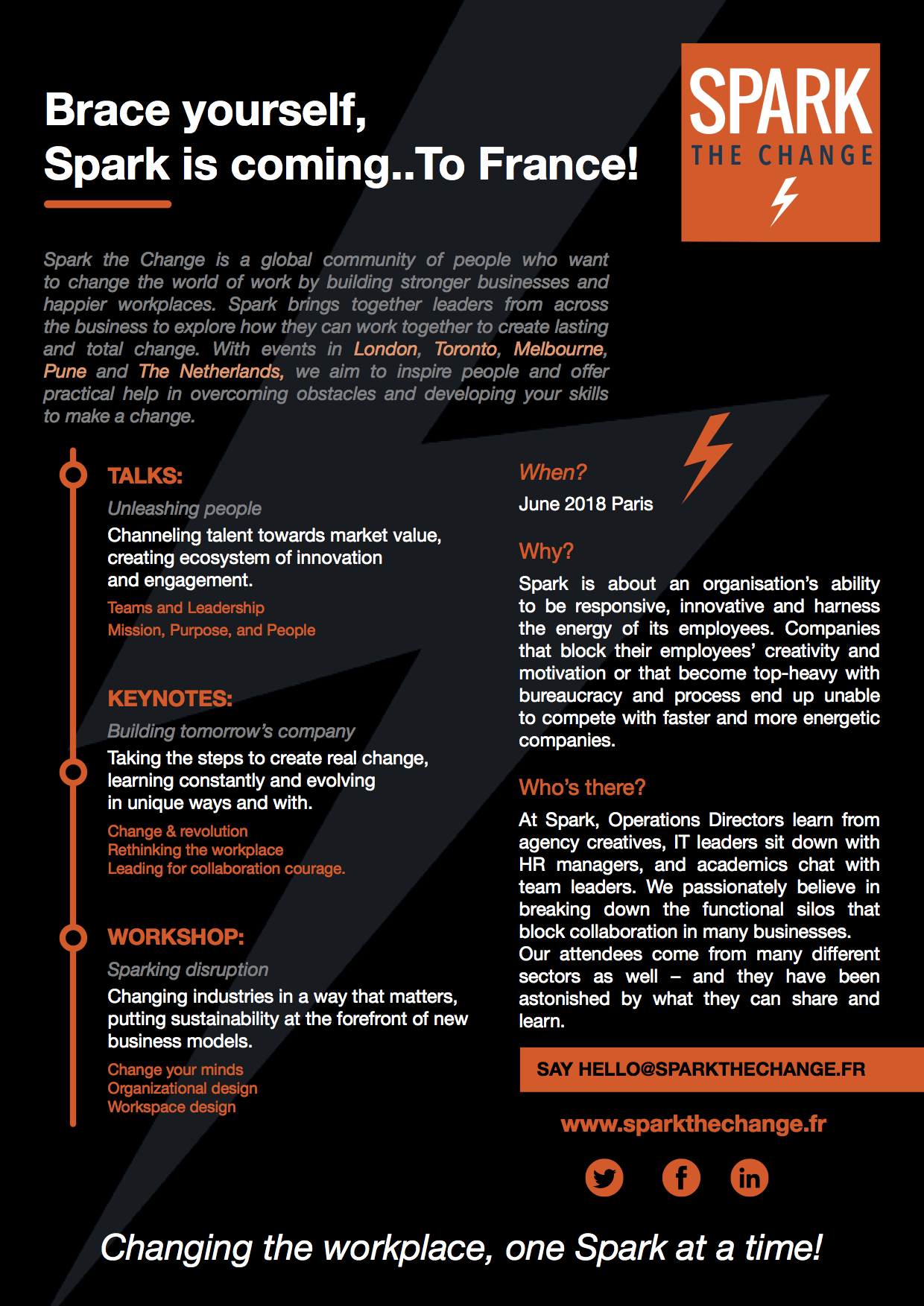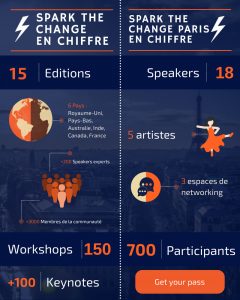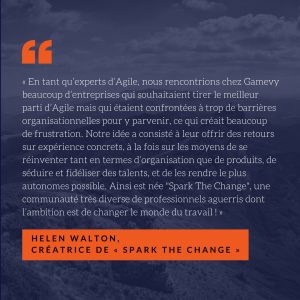Brace yourself Spark the change is coming..To France!


Also published on Medium.

Self selection – How to restructure your team for greater autonomy.
One of our largest departments within Ocado Technology recently undertook a revolutionary self-selecting restructuring exercise, changing the entire structure of the department whilst allowing all team members to choose which team they would like to work in going forward. The need came about because multiple teams were stretched, working across two major business propositions and context switching between them. The goal was that following the restructure there would be a clear split between teams working on two different business propositions, such that each of those teams could really focus on that product.

The overall aim of this restructure was to achieve greater alignment, autonomy and purpose.
Following the principle that a collaborative and distributed approach is often the best way to solve a complex optimisation problem, we decided to take a full day as a whole department to stop work and have a facilitated event to negotiate the moves amongst the five new teams. We did a lot of thinking and preparation prior to this day and the teams used a set of constraints around team size and experience levels to guide their decisions.
The plan going into the event was shared well ahead of time to allow people to get their questions in (and added to a shared FAQ forum) and to be sure the concepts were clear going into the day. Alongside this, we ran multiple “townhall” sessions where people could air their concerns and ask their questions openly. We hoped that at the end of the process we would have well-rounded, committed teams ready to face the new challenge.
There was a certain amount of ad-libbing and practical adjustments on the day, but on the whole it unfolded according to the plan:
– First, a pitch for each team by the Product Owner, covering the vision/roadmap and why the team is super cool and awesome. There was also a set of target criteria for each team as a guide for what we were looking to achieve in each area.
– Next, multiple iterations where we:
1. Assigned or moved ourselves/each other between teams until we’ve addressed any identified issues in the previous iteration.
2. See if we had met the pre-defined criteria for each team.
3. Repeat until we run out of time or we meet all of the requirements and everybody is happy and committed to the team that they are in.
Fuelled by 18 pizzas, we completed three exhausting rounds of moves and peer voting. At the end of each round, we (everyone, including Product Owners and Team Leads) voted on the viability of each team. From this we measured two scores: an intra-team score (the people in that team scoring the viability of the team), and an inter-team score (the rest of the people scoring the viability of that team). This lead to a few interesting dynamics, for example one of the teams gave themselves a high intra-team score, but scored low on the inter-team vote. They then gave a pitch justifying their viability as a team, and were able to dramatically increase their inter-team score in the next round.
The first round was deliberately obviously suboptimal, so that everyone was motivated to suggest changes and improvements and become comfortable with doing so in a very “safe” way. Naturally, this configuration had dramatically lower scores! This encouraged a large amount of movement in the following rounds, as we had hoped.

Essential to finding a viable solution was an appreciation from all of the ‘greater good’ of Ocado Technology. On the day, some people chose to make some really big compromises in order to serve the greater good and allow us to form balanced teams that are all capable of smashing out quality software.
After the final round of voting we then took a quick anonymous happiness reading by each dropping a green, yellow or red lego piece into a box. Although they were not perfect, we were extremely pleased the results, considering that our original goals was “at least 50% happy”.

The very next morning we did a big-bang desk move:

We’ve since kept a close eye on the impact of the shuffle-up by measuring the things that matter most to us: throughput and team happiness. There was an expected initial dip in throughput as many people got up to speed on new products they had not worked on before and as new teams gelled and got to know each other. But the throughput three months on has risen higher than before the change and still rising. Improvements in team happiness (measured before and after by Spotify’s “health-checks”) were noteworthy from straight after the restructure.
In terms of the solution itself: we are delighted. Every team has a reasonable level of experience whilst a healthy number of people have chosen to change domain. It is a vastly better result than we could have hoped for had we chosen a top-down approach and the sense of autonomy it has created is invaluable. It seems that teams and individuals have a stronger sense of ownership than ever before and that they are taking quality more seriously than ever before. This did have an up-front cost in terms of short term throughput, but the long term benefits certainly justify it.
James Lohr, Ocado Tech Department Head

Gig Economy
You could drive yourself steadily insane compiling a list of all the trends that were supposed to fundamentally reshape business. Once upon a time we were all “flexi” workers, then “mobile learners”. Both terms seem antiquated now, the corporate equivalent of a Segway – perfectly sensible in principle but somehow faintly ridiculous in reality.
What makes the “gig economy” – the legion of individuals taking on piecemeal work, enabled by online talent platforms – feel different is that it’s being driven not by hip early adopters in co-working spaces (though there are plenty of them involved too) but by genuine need, both in the “real” economy and, crucially, in boardrooms.
If you were staffing a major new project from scratch today, it would seem an act of faint lunacy to bring in a raft of full-time employees with cumbersome overheads (and personal taxes) when you could go online and find experienced, verifiable individuals you could pay by the hour and dispose of when required. Similarly, if you were a coder, IT contractor or other technical specialist, why would you harness yourself to one organisation when you could enjoy both variety and a more lucrative income hopping from gig to gig (along with the attendant tax advantages of being self-employed)?
So many businesses are waking up to this recalibration that 450,000 people with full-time jobs now have second jobs, many of them via TaskRabbit, Elance or their multitude of competitors. PwC has tried to cut out the middleman by setting up its own talent “market” of registered suppliers its offices can bid on. There are individuals in greater London making a handsome living assembling flat pack furniture on a piecemeal basis for an hourly rate – an occupation that would have been almost logistically impossible just a couple of years ago.
You can understand the appeal of living by the gig, beyond the financial benefits. The conventional career has been an awkward fit for many people over the years, and few jobs are capable of maximising all our skills and intelligences. Besides, most work is boring, which is why those lucky enough ever to have had a job for life employed the conversational repertoire of the prison system (“putting in hard graft”, “serving your time”) to describe it.
Gigs, by contrast, are exciting and ever-changing, even though they ask some deep questions of the psychological contract (why would I exercise discretionary effort for a business that only employs me for a matter of days? Can I trust someone who could work for my biggest rival tomorrow?). But they aren’t an untrammelled good, either. For every actuarial scientist earning a small fortune for a short-term job, there’s a hotel chambermaid who is now being paid by the room rather than the day. The huge rise in self-employment in the UK has as much to do with businesses shifting such workers – we should include the small army of couriers and delivery drivers in this calculation – off their books as it does people discovering new freedoms. Palpably, none of them are enjoying the benefits of the gig economy, not least because they cannot practically control where and how they work. They are left, instead, to feed on scraps.
Uber, the erroneously attributed poster child of the gig economy, faces a legal challenge over whether its drivers are technically employees. It maintains they are self-employed. This is a vital point for the courts to consider – cycle couriers and plumbers are engaged in similar cases – but in Uber’s case we should also note that it controls the supply of drivers into the market, and their pricing. This is assuredly not the “freedom” gig economy enthusiasts speak of.
Governments will have to decide the legal and ethical boundaries of such behaviours, not least because if gigs take off, their tax revenues will rapidly vanish. Already, there is serious talk of the need for a third kind of classification, between “employee” and “self-employed” which recognises the shared responsibilities (both financial and relating to holidays, sick pay and other benefits) between giggers and those they work for.
Pioneers like Wingham Rowan, who runs the Beyond Jobs consultancy, are trying to imagine a market that will ensure the gig economy brings mutual benefits and conveniences without being open to abuse. Businesses who want to enjoy the flexibility such arrangements provide should not absent themselves from such discussions – but neither should they fear this will turn out to be just another fad.
By: Robert Jeffery, Editor of People Management magazine

Spark the Change : inspirer les entreprises françaises grâce à des retours sur expérience concrets
Selon un sondage récent de l’Ifop, 91 % des jeunes cadres français pensent que leur entreprise est en train ou va se transformer. Mais pour 47 % des entreprises, la transformation reste aujourd’hui synonyme de « digitalisation ». Elle ne concerne l’évolution du style de management que dans 21 % d’entre elles et la relation client dans seulement 20 %. Pourtant, ces cadres pensent que la priorité devrait être mise sur l’évolution des modes de rémunération des salariés (37 %), l’évolution des styles de management (33 %) et la formation et le développement de compétences (33 %).
Les jeunes cadres français ont bien compris que loin de se cantonner à la digitalisation des processus, la transformation concerne de nombreux aspects de la vie de l’entreprise, et surtout sa culture et son organisation. « Une entreprise ne peut réussir sa transformation digitale si elle n’a initié une profonde transformation en interne » explique Jean-Christophe Conticello, fondateur et CEO de Wemanity.
« L’apparition d’Internet et des technologies associées a bouleversé en profondeur le monde de l’entreprise. Les modes de consommation ont évolué, le temps s’est accéléré, ce qui a entrainé également une profonde évolution des modes de travail. La nécessité de changer est devenue vitale : on ne compte plus les entreprises qui, en hésitant à changer de recette, n’ont pas réussi à se renouveler et ont disparu : Kodak, Virgin Megastore, Nokia, BlackBerry, Yahoo!, etc. Non seulement, la nouvelle génération a compris cette nécessité de changement, mais elle le suscite avec les nouveaux modes de travail qu’elle privilégie. »
 « Spark the Change » : décrypter et inspirer les bonnes pratiques
« Spark the Change » : décrypter et inspirer les bonnes pratiques 
Pour illustrer et expliquer cette évolution, l’événement « Spark the Change » a été créé à Londres en 2014 par Helen Walton et ses associés de Gamevy, avec le soutien de Wemanity, puis décliné en Australie, aux Pays-Bas, en Inde et au Canada. La première édition française sera organisée à Paris, le 26 juin prochain au Théâtre de la Madeleine.
Centré sur le futur du travail et les moyens de repenser l’entreprise de demain, « Spark the Change » propose aux entreprises françaises un programme de conférences de qualité, basé sur des retours d’expérience.
18 experts se succèderont sur scène pour décrypter les tenants et aboutissants de la transformation des entreprises. Parmi eux : Ludovic Huraux, CEO et fondateur de Shapr ; Dirk Ahlborn, CEO Hyperloop Technology ; Anthony Gooch Galvez, Directeur de la communication et des Affaires publiques à l’OCDE ; Anamita Guha, Product Manager, IBM Watson ; Marianne Syed, Executive Director chez Positive Planet UK. Et bien sûr, Arie Van Bennekum, seul rédacteur européen du Manifeste Agile, aujourd’hui Agile Thought Leader chez Wemanity et Jurgen Appelo, CEO et fondateur d’Agility Scales et expert du management 3.0.
3 thèmes principaux
Animées par des professionnels de toutes nationalités qui souhaitent faire évoluer le monde du travail, les conférences « Spark the Change » sont réparties dans trois sessions principales :

- Créer l’entreprise de demain : les différentes étapes pour insuffler un véritable changement dans l’entreprise, sur la base d’un apprentissage continuel, d’une maîtrise totale des technologies et d’une organisation plus agile et réactive.
Jurgen Appelo, CEO et fondateur d’Agility Scales, expliquera notamment dans quelle mesure il est essentiel pour une entreprise d’aider ses collaborateurs à maîtriser continuellement le changement, par exemple via la ludification et d’autres nouvelles pratiques. - Libérer les talents : développer le potentiel de chaque collaborateur, instaurer le bien-être au travail, booster la collaboration et créer un environnement de travail basé sur la confiance.
Anthony Gooch Galvez, Directeur de la communication et des Affaires publiques à l’OCDE, détaillera ainsi « l’Indicateur du vivre mieux » de l’OCDE qui permet de comprendre ce qui contribue au bien-être des individus et des pays, et d’identifier comment susciter plus de progrès pour tous. - « Sparking disruption » : privilégier l’innovation, voire la disruption ; remettre en cause le statu quo ; et valoriser le progrès social, technologique et culturel.

Dans cette session, Dirk Ahlborn, CEO Hyperloop Technology, dévoilera la genèse de la création d’Hyperloop qui, au-delà des records de vitesse et des nombreuses innovations qui le caractérisent, propose surtout de révolutionner l’expérience des usagers du train.
« Spark the Change a été créé pour inspirer les entreprises, à l’heure où elles sont confrontées à plusieurs évolutions stratégiques : la transformation numérique, l’évolution démographique, la co-innovation voire la “coopétition” sur des marchés mondialisés » explique Sabri Ben Radhia, Responsable de l’événement chez Wemanity. « Si Wemanity était présent lors des premières éditions internationales de Spark the Change en tant que sponsor, nous avons repris la marque et sommes devenus son organisateur principal. Réservé à la fois aux entreprises et aux institutions publiques, l’événement a pour objectif de couvrir l’ensemble des aspects relatifs à la transformation des entreprises, sur la base de très nombreux retours d’expérience. Il vise également à aider les entreprises à développer les compétences nécessaires pour mener à bien leur transformation ».
Le programme de la journée a été construit pour privilégier l’échange d’expériences et le networking. 750 personnes issues de l’ensemble de l’écosystème de l’innovation européen sont attendues le 26 juin prochain au Théâtre de la Madeleine.
Aurons-nous le plaisir de vous compter parmi eux ?
Plus d’information sur l’événement : http://sparkthechange.fr/about-us/
Les experts qui interviendront dans les conférences : http://sparkthechange.fr/speakers/
Inscription : http://sparkthechange.fr/tickets/
Also published on Medium.

